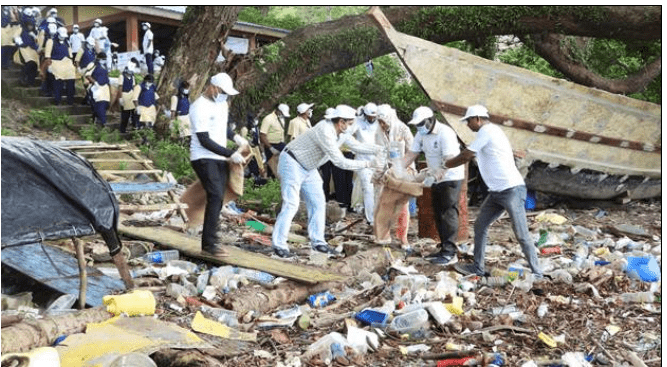Sri Vijaya Puram: To tackle plastic pollution and raise awareness about marine conservation, a coastal clean-up campaign held at Hopetown Beach on July 8 removed over 700 kilograms of waste from the shoreline. The drive was part of Swachhata Pakhwada (July 1–15), a nationwide sanitation initiative, and was spearheaded by the Atal Centre for Ocean Science and Technology for Islands (ACOSTI), a field unit of the National Institute of Ocean Technology (NIOT) under the Ministry of Earth Sciences.
The campaign, which also featured hygiene awareness activities at Vitala Public School in Sri Vijaya Puram, brought together 103 volunteers from various walks of life. Participants included NIOT-ACOSTI staff, school students, teachers, panchayat members, and local villagers. The collective effort led to the removal of 712.8 kilograms of marine debris, which was handed over to the local Panchayat for systematic disposal.
Officials at NIOT described the initiative as an example of science-led community engagement aimed at preserving the fragile coastal ecosystems of the Andaman and Nicobar Islands. Apart from the clean-up, educational outreach focused on discouraging the use of single-use plastics, encouraging sustainable waste management, and promoting individual responsibility in maintaining coastal hygiene.
The event was further supported by the presence of elected local representatives, including the Zilla Parishad Member from Bambooflat and the Panchayat Pradhan of Hopetown. Their participation added weight to the initiative and encouraged further community involvement. While no speeches were made, their presence underscored growing local consensus that ocean waste is no longer just a government concern but a public health and livelihood issue.
NIOT also distributed essential sanitation supplies and daily-use items to both the school and the panchayat office. These included hygiene kits, cleaning tools, and reusable items aimed at encouraging behavioural change toward better sanitation practices. Officials said the gesture was part of NIOT’s larger mandate to combine scientific research with community outreach in India’s island territories.
Hopetown Beach, which serves both as a recreational zone and a marine biodiversity hotspot, has long struggled with the accumulation of plastic waste, largely due to poor disposal habits and floating debris carried by ocean currents. During the drive, volunteers found everything from plastic bottles and fishing nets to footwear and packaging materials.
Organisers said the clean-up effort was not a one-time event but part of an ongoing push to develop an environmentally conscious culture in the islands. They also noted that the campaign served as an experiential learning opportunity for schoolchildren, who not only took part in the clean-up but also attended mini-sessions on ocean ecology and plastic alternatives.
NIOT’s ACOSTI centre has been active in the islands for several years, primarily focusing on oceanographic research, sustainable coastal development, and technology demonstrations. By integrating local-level sanitation drives with its scientific mandate, the centre is looking to create synergy between research, policy, and public participation.
In recent years, the Andaman and Nicobar Islands have seen increased waste pressure due to tourism, shipping, and urbanisation. While government departments have launched multiple Swachh Bharat-linked clean-up drives, officials say long-term success will depend on year-round vigilance and community cooperation.
As the Swachhata Pakhwada continues until July 15, ACOSTI and other participating bodies are expected to organise additional outreach activities across the islands. These may include street plays, school competitions, and awareness walks, all aimed at embedding the idea that clean coasts are not just good optics, but essential for marine health and sustainable development.
With over 700 kilograms of waste cleared in just one day, the Hopetown event may be symbolic, but it also points to the scale of the challenge, and the power of collective action.



